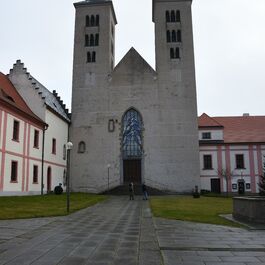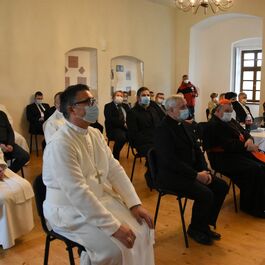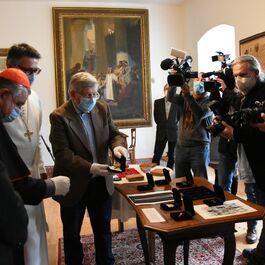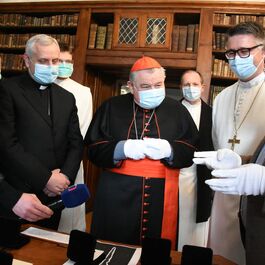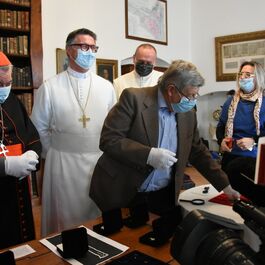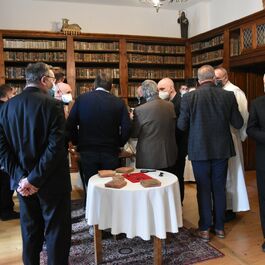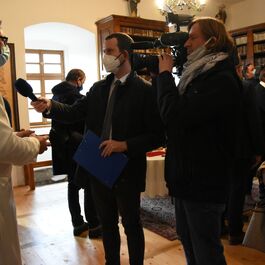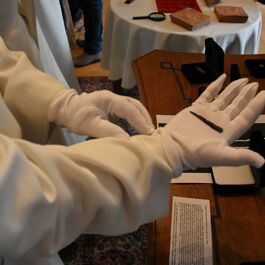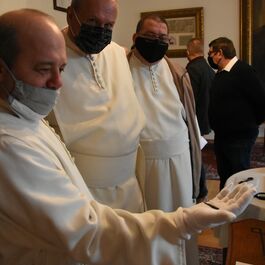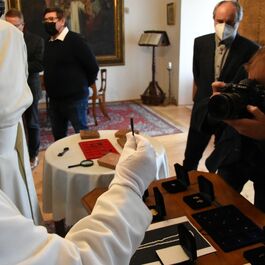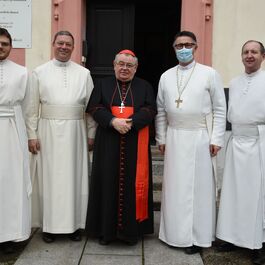Presentation of the Holy Nail in Milevsko 2020
In the Milevsko Monastery, a presentation of a significant relic, which was discovered in the summer of 2020, took place.
Created on: 23. 12. 2020
In the summer of 2020, a discovery was made in the Milevsko Monastery that has significance beyond just our country's borders. In the Church of St. Giles, a hidden cache was discovered, and within it another secret passage that concealed an incredibly valuable relic — the Holy Nail. The find has been dated to the 4th century. While it is not possible to determine if this nail is truly the original nail that was used to crucify Jesus, the way it was decorated and stored indicates a strong belief that it was indeed an original relic of Jesus' crucifixion.
Along with the nail, which measures approximately 6 cm, remnants of two containers in which the relic was stored were also retrieved. The older oak container was radiocarbon dated to between 338 and 416 AD. Its lid was adorned with a golden cross featuring the inscribed letters IR (Iesus Rex = Christ the King). The second container was made of larch wood. When fragments of the pigments used to decorate the containers were analyzed, a surprising discovery was made: the containers were decorated with ultramarine paint. Dark ultramarine, or true ultramarine, is a rare color obtained through a complex process of grinding the semi-precious stone lapis lazuli. There is only one source of this mineral in the world, located in present-day Afghanistan. The rarity of the color is suggested by its name, derived from the Latin "ultra" (beyond, further, thus also across, from beyond) and "mare" (sea). This color is extremely rare in our region. When the epitaph stone at the Golden Gate of St. Vitus Cathedral was being restored after 2000, the restorers, like the original author, wanted to use natural ultramarine for the inscription. One hundred grams of this color was then up to three times more expensive than the same amount of gold, recalls restorer Tomáš Rafl, who worked on the cathedral. The high price of the pigment is due not only to the unique origin of the stone but also to the very lengthy and demanding production process. It is said that, for example, Michelangelo could not afford ultramarine. His famous contemporary, the painter and architect Raphael, used it only on well-visible parts of surfaces due to its high cost. A synthetic version of the pigment has existed since 1824, but it cannot replicate the unique light refraction offered by natural ultramarine (source: Aktuálně.cz).
During the research of the nail, the possibility that the nail itself contained a hidden cavity, for example, to store metal shavings from the true nail of the true cross, had to be investigated. This idea came to the scientists due to the preserved Longinus' Spear, which, according to legend, was used by the Roman soldier Longinus to pierce the side of the crucified Jesus Christ after his death. The preserved spear, however, was probably made in the 8th century, and a piece of the alleged nail from the true cross was inserted into its blade during its manufacture. Therefore, archaeologists speculated that under the golden cross on the wider side of the nail, there might be a small reliquary compartment. Experts at the CTLAB CEITEC X-ray computed tomography laboratory X-rayed the entire nail.
"During the tomographic inspection, over 2000 X-ray images were taken, from which a 3D model of the nail with complete information about its internal structure was subsequently created. The main area of interest was the 21-carat cross, under which, according to archaeologists, a reliquary compartment might have been located. However, we have completely ruled out the presence of any cavity," says Michaela Škaroupková, business and marketing director of CTLAB CEITEC.
The relatively simple equipment of the reliquary corresponds to the ancient Byzantine reliquaries we know. The find can be dated to the period when, according to legend, Saint Helena (later canonized) found the remnants of the crosses and other relics associated with the crucifixion of Jesus Christ. The date of their discovery is considered to be September 13, 326 AD.
"It is unusual that we have no preserved information about such a significant relic, and it was not even located at the main altar. Therefore, the question arises as to how it arrived in Milevsko. The circumstances suggest that it might not have been acquired legally. Any handling of such a valuable relic was subject to strict regulations and permission from the ruler," says Dr. Pavel Břicháček, head of the archaeological research, pointing out other mysteries surrounding the nail that still await resolution.
More information can be found on the website Aktuálně.cz.
Photos were taken by Brother Václav. Thank you.



